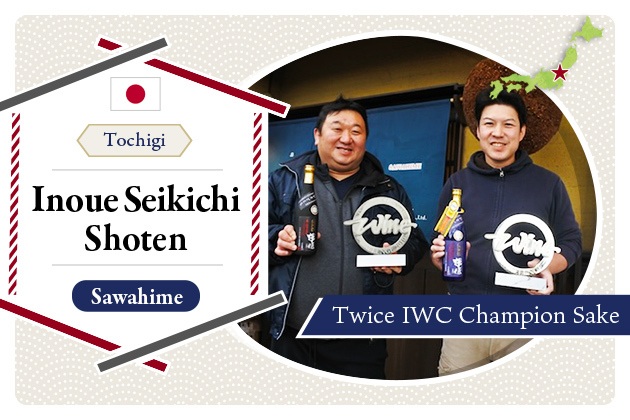
2024.02
07
Citric Acid Brought Revolution to Sake Brewing - Learn about White Koji and Black Koji
Koji, which is essential for sake brewing, involves three main types: yellow, white, and black. Traditionally, sake brewers have used yellow koji in the brewing process, but in recent years, white koji, used in shochu production, and black koji, used in awamori (Okinawa shochu) have become popular. White and black koji make a significant difference in the flavor of sake and this excites many sake brewers about expanding the flavor profiles in sake.
Differences in koji by color
Yellow, white, and black koji were given names based on their appearance. Each koji has a different use because they bring about a significant change in flavor. Generally, yellow koji was used in sake production, white koji in shochu, and black koji in Awamori or shochu making. These varieties are also seen in terms of their strength of the enzyme that breaks down starch and the amount of citric acid produced.
Yellow koji is a type of koji made from a kind of fungus Aspergillus oryzae, which has long been used not only in sake brewing but also in fermented foods such as miso and soy sauce. It has strong saccharification properties, but produces little citric acid. It has a yellowish to greenish color in appearance.
Black koji is produced by Aspergillus luchuensis, which is black in color and originated in Okinawa. Compared to yellow koji, black koji is less potent in breaking down starch, but produces more citric acid, which prevents the growth of miscellaneous bacteria. For this reason, it is useful for brewing in hot and humid regions such as Okinawa and Kyushu, and has been used mainly to make awamori and shochu.
White koji is made from Aspergillus kawachii, a mutation of black koji mold, which produces a lot of citric acid like black koji. Contrary to its name, it is brownish in color, but named so because it is whiter than black koji, the mutation source. Since it is easier to handle than black koji, it has become the mainstay of shochu brewing.
These koji have been used for specific purposes to take advantage of their characteristics. In recent years, however, with the advancement of research, other types of koji besides yellow koji are also being used in sake brewing.
Citric acid brings new possibilities
Characteristics of white koji
As mentioned above, the biggest difference between white koji and yellow koji is that the former produces a large amount of citric acid. Citric acid is a sour component found in citrus fruits and plums. In recent years, sake made with white koji has been attracting attention, as citric acid gives it a unique flavor with a refreshing citrus-like acidity.
Another difference between white and yellow koji is the enzyme power. As seen in Table 1, white koji has a smaller amount of enzymes that break down starch than yellow koji, and among enzymes that break down protein, it has a larger amount of acid protease and a smaller amount of acid carboxypeptidase. One might think that the fact that there are fewer enzymes that break down starch to sugar means that alcohol fermentation will not proceed.
However,
1)compared to yellow koji, α-amylase of white koji has a smaller ratio of invalid adsorption to rice
2)white koji α-amylase has excellent resistance to acid and alcohol, and is not easily deactivated even in the late stage of fermentation.
For these two reasons, although the initial fermentation is rather slow, sufficient alcohol can be produced in the end. On the other hand, sake made with white koji, in fact, is often made these days with a sweet taste to balance the acidity of citric acid.
Furthermore, one might think that the high amount of acidic protease would break down the protein and produce more amino acids, resulting in a more flavorful sake, but since the breakdown of the rice itself proceeds slowly, according to experimental results, the amount of amino acids produced is rather less than with yellow koji, and the amount of peptides before the protein is broken down to amino acids is higher.
*Acid proteases break down proteins into peptides, and acid carboxypeptidases break down peptides into amino acids.
Reference: Journal of the Brewing Society of Japan, 85-2, Fermentation Characteristics of Sake Mash made by using Rice Koji prepared with Aspergillus kawachii, Akihiro Nakamura and others, 1990
In order to keep the amount of citric acid produced within a certain range and to ensure the ability to break down starch, a blend of yellow and white koji are used in sake production, but there are exceptions. This is also the case with black koji, which will be discussed later.
Utilizing citric acid for making yeast starter
Another area of focus is the function of citric acid in white koji during yeast starter making. In the process of making the yeast starter, it is necessary to create an acidic environment to prevent the growth of bacteria that can hinder the growth of the yeast.
The mainstream method for creating an acidic environment is called sokujo, in which lactic acid for brewing is added to create a sake mother. On the other hand, the traditional methods of making sake using the traditional methods of kimoto and yamahai use lactic acid, produced by natural lactic acid bacteria to create an acidic environment, but these methods are more difficult to control hygiene and take nearly twice as long as the sokujo method.
Recently, a method that has come into use is to create an acidic environment in the yeast starter using citric acid produced by white koji. This method allows the starter to be made in about the same amount of time as that required for sokujo. Furthermore, this method can also be used to produce sake without additives, which has become a requirement due to changing consumer tastes and exports to overseas markets.
Black koji produces flavors like strawberries and red wine
Characteristics of black koji
The most important characteristic of black koji is that, like white koji, it produces a lot of citric acid. Sake made with black koji has become increasingly common, but the number is still small compared to white koji.
Generally speaking, black koji produces more citric acid than white koji. The same is true for white koji, which has an aroma that takes advantage of the acidity of citric acid and often leaves a sweet taste to balance the acidity.
In addition, black koji has weaker starch/protein decomposition ability than white koji. Table 2 compares the enzyme content of white koji rice for shochu, black one for awamori, and yellow one for sake. Although it is not possible to make a general comparison due to the different characteristics of the raw materials and production methods, the overall enzyme content of black koji for Awamori is lower than that of white koji for shochu.
We could not find any studies or experiments comparing the composition of sake made with white koji and black koji, but as seen earlier, in the case of white koji, the rice dissolves more slowly, resulting in less amino acid formation and more peptide content. In the case of black koji, which has a smaller amount of enzymes than white koji, this tendency may be even stronger and peptides may tend to be more abundant. Compared to amino acids, which have a variety of tastes such as "umami, bitter, and sweet," peptides are particularly prone to bitter tastes. This is shown when reviewing tasting comments on black koji sake that seem to focus on the bitterness. Due to its high acidity and unique bitterness, its taste is sometimes compared to that of strawberries or red wine.
Reference: Journal of the Brewing Society of Japan, 83-12, Characteristics of Various Enzymes of Shochu White Koji, Kimio Iwano and Shigeaki Mikami, 1988
Earlier mentioned Aspergillus lucuencis as the name of black koji fungus, but you may have heard of Aspergillus awamori. However, according to the recent research:
- Aspergillus awamori actually combines Aspergillus luchuensis and Aspergillus niger, which is a completely different black koji
- Other fungi that have been called by various names have similar characteristics to Aspergillus luchuensis
These facts led to the unification of the name to Aspergillus luchuensis (derived from Ryukyu, the old name of Okinawa) in 2013.
Reference: Journal of the Brewing Society of Japan, 110-2, The scientific name for black yeast fungus is now Aspergillus luchuensis, Osamu Yamada, 2015
Summary
Koji plays an important role in sake brewing. Yellow, white, and black koji have their own characteristics, and in the past, each had its own use: yellow for sake, white for shochu, and black for awamori, but now we can transcend these barriers and enjoy a new range of styles and flavors in our sake.
Pickup Articles
2019.01.18
2019.01.25
Trending Articles
Popular Articles
Recent Articles












